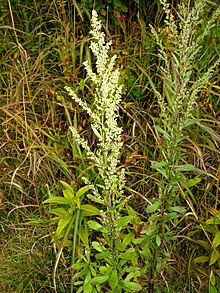
Forsythia, is a genus of flowering plants in the olive family Oleaceae. There are about 11 species, mostly native to eastern Asia, but one native to southeastern Europe. Forsythia – also one of the plant's common names – is named after William Forsyth.

Buchozia japonica is a species of flowering plants in the family Rubiaceae. It is the sole species in genus Buchozia. It is native to open sub-tropical woodlands and wet meadows in southeast Asia, from India, and China to Japan. It is commonly called the snowrose, tree of a thousand stars, or Japanese boxthorn; and was formerly called Serissa. Snowrose and tree of a thousand stars are different cultivars. The only method of differentiating is measuring the difference in the shape and size of the flowers produced.

Artemisia is a large, diverse genus of plants belonging to the daisy family Asteraceae, with between 200 and 400 species. Common names for various species in the genus include mugwort, wormwood, and sagebrush.

Lonicera japonica, known as Japanese honeysuckle and golden-and-silver honeysuckle, is a species of honeysuckle native to eastern Asia, including many parts of China. It is often grown as an ornamental plant, but has become an invasive species in a number of countries. Japanese honeysuckle is used in traditional Chinese medicine.

Artemisia vulgaris, the common mugwort, is a species of flowering plant in the daisy family Asteraceae. It is one of several species in the genus Artemisia commonly known as mugwort, although Artemisia vulgaris is the species most often called mugwort. It is also occasionally known as riverside wormwood, felon herb, chrysanthemum weed, wild wormwood, old Uncle Henry, sailor's tobacco, naughty man, old man, or St. John's plant. Mugworts have been used medicinally and as culinary herbs.
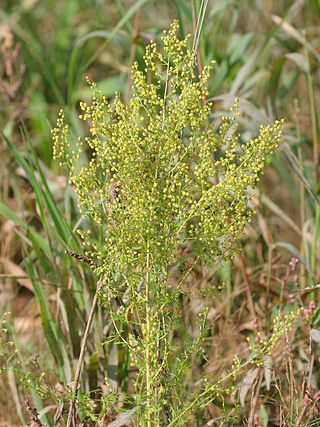
Artemisia annua, also known as sweet wormwood, sweet annie, sweet sagewort, annual mugwort or annual wormwood, is a common type of wormwood native to temperate Asia, but naturalized in many countries including scattered parts of North America.
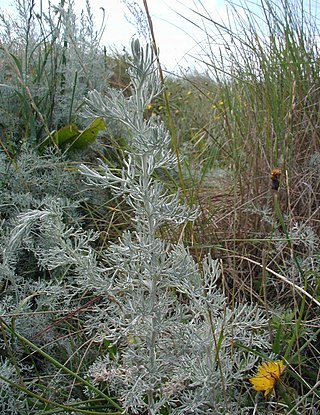
Artemisia maritima is a European species of wormwood known as sea wormwood and old woman. It is native to France, the United Kingdom, Italy, Belgium, Germany, Denmark, Sweden, Bulgaria and Russia.

Artemisia abrotanum, the southernwood, lad's love, or southern wormwood, is a species of flowering plant in the sunflower family. It is native to Eurasia and Africa but naturalized in scattered locations in North America. Other common names include: old man, boy's love, oldman wormwood, lover's plant, appleringie, garderobe, Our Lord's wood, maid's ruin, garden sagebrush, European sage, sitherwood and lemon plant.
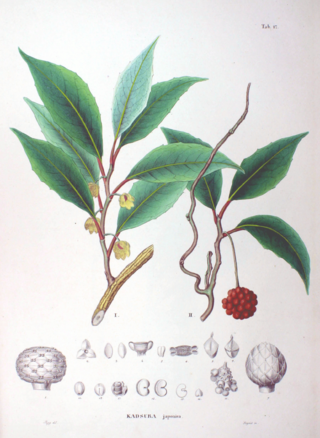
Kadsura japonica, commonly known as the kadsura vine or simply kadsura, is a plant species native to Japan in woodlands. The larvae of the moth Caloptilia kadsurae feed on K. japonica in the main Japanese islands and Ryukyu Islands.

Anemone hepatica, the common hepatica, liverwort, liverleaf, kidneywort, or pennywort, is a species of flowering plant in the buttercup family Ranunculaceae, native to woodland in temperate regions of the Northern Hemisphere. This herbaceous perennial grows from a rhizome.
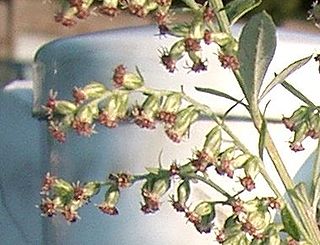
Artemisia princeps, also commonly called yomogi, Japanese mugwort, Korean wormwood, Korean mugwort or wormwood in English, is an Asian plant species in the sunflower family, native to China, Japan and Korea. It is a perennial, very vigorous plant that grows to 1.2 meters. This species spreads rapidly by means of underground stolons and can become invasive. It bears small, buff-colored flowers from July to November which are hermaphroditic, and pollinated by wind. The leaves are feather shaped, scalloped and light green, with white dense fuzz on the underside.

Artemisia biennis is a species of sagebrush known by the common name biennial wormwood. It is a common and widely distributed weed, so well established in many places that its region of origin is difficult to ascertain. This species is most likely native to northwestern North America and naturalized in Western Europe, and eastern and southern North America.
Ericameria compacta, the Charleston Mountain goldenbush, is a rare North American species of flowering plants in the family Asteraceae. It has been found only in pine forests in the Spring and Sheep Mountains of Clark County, Nevada. Fewer than 12 populations have been found.

Hypericum patulum, known as goldencup St. John's wort or yellow mosqueta, is a species of flowering plant in Hypericumsect. Ascyreia.

Eriocapitella japonica is a species of flowering plant in the buttercup family Ranunculaceae. The specific epithet japonica means "from Japan", which is a misnomer since the species is introduced in Japan. It is native to China, Taiwan, and Vietnam.

Helwingia japonica, the Japanese helwingia, is a species of flowering plant the family Helwingiaceae. It is native to South-East Asia.

Artemisia capillaris,, is a species of flowering plant in the wormwood genus Artemisia, family Asteraceae.
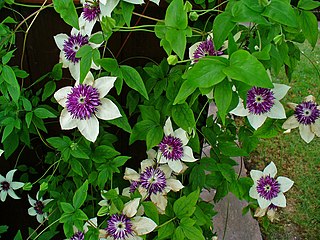
Clematis florida, the Asian virginsbower, or passion flower clematis, is a species of flowering plant in the family Ranunculaceae. It is native to southern China, and has been introduced to Korea and Japan. A perennial vine, in the wild it is typically found in shrublands and thickets, and alongside streams, at elevations around 1,700 m (5,600 ft). There are a number of cultivars commercially available, including 'Sieboldiana', Pistachio 'Evirida'PBR, and 'Plena'.

Artemisia laciniata is a species of wormwood in the family Asteraceae. Its common name is the Siberian wormwood. It is mostly found in Russia, Alaska, the Yukon, and other parts of the US and Europe.
Artemisia indica, the Indian wormwood, is a widespread species of flowering plant in the family Asteraceae. It is native to the Indian Subcontinent, mainland Southeast Asia, China, Taiwan, the Philippines, Korea, the Ryukyu Islands, and Japan, and it has been introduced to Peninsular Malaysia. In the wild it is typically found alongside roads, on slopes, in forest edges, and in scrublands at elevations below 2,000 m (6,600 ft).
